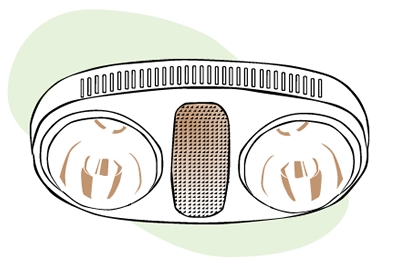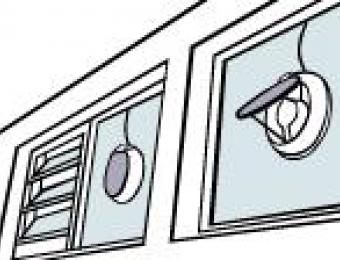Heat lamps are incandescent light fixtures whose main purpose is to provide a focused source of heat, although they also provide light as well. Heat lamps are most commonly used in places like showers and bathrooms, which are often the coldest places in the house – particularly in winter. Their advantage in these rooms is that they provide fast, radiant heat, and are reasonably economical to use for short periods. Likewise, they're often integrated into waterproofed units that also incorporate an exhaust fan.

How do heat lamps work?
Traditional light bulbs work by heating the tungsten filament in the bulb to such a high degree that it produces visible light energy. Heat lamp bulbs, on the other hand, have optimised filaments (usually made out of quartz) that resist electricity, resulting in the production of excess amounts of infrared radiation, which acts directly to heat the human body. Heat lamp bulbs normally include internal reflectors which serve to focus the light and heat straight down on a specific area.
Standard heat lamp bulbs typically consume about 200-250 watts of power, and as such are considerably more efficient than radiant bar heaters. Heat lamps can be quite bright, and the bulbs often feature red filters to reduce the amount of visible light they emit.
Electric heat lamps are typically designed for domestic use, and come in all kinds of shapes and styles. They can be wall-mounted, recessed, free standing, and they are often integrated with an exhaust fan for ventilation purposes. These types of units normally feature separate switches for the fan and the heat lamp components.
Where should I use one?
Heat lamps are designed to provide a small but concentrated source of heat, which makes them ideal for use in smaller areas like bathrooms, or to complement the heating in larger areas. There are heat lamps available that can be used in the kitchen to keep food warm as well. As most of the light will be blocked by the red filters (and because they're far less efficient than most 'light' bulbs), it’s generally inadvisable to use heat lamps as your primary lighting unless it’s for a relatively confined space, and where you need heat as well.
If you are planning to put a heat lamp in your bathroom, be sure to check that your bulb is waterproofed to a rating of IP67. Avoid positioning the heat lamp too close to things like towels or clothes, as they can be burnt. Heat lamps are most commonly instsalled on the ceiling to optimise their use - normally just above the space where you step out of the shower to dry yourself.
Heat lamps are also said to have therapeutic benefits, helping to provide relief for muscle aches and pains. While basking in the warmth from a heat lamp can be soothing, it’s important to remember not to stand too close to one for too long, as your skin can get burnt from overexposure to the intense heat.
How energy efficient are heat lamps?
Although heat lamp bulbs operate on a slightly higher wattage than other incandescent light bulbs, they're relatively energy efficient as far as instant sources of heat go.
Heat lamps should be installed by professional electricians.
|
Advantages
|
Disadvantages
|




